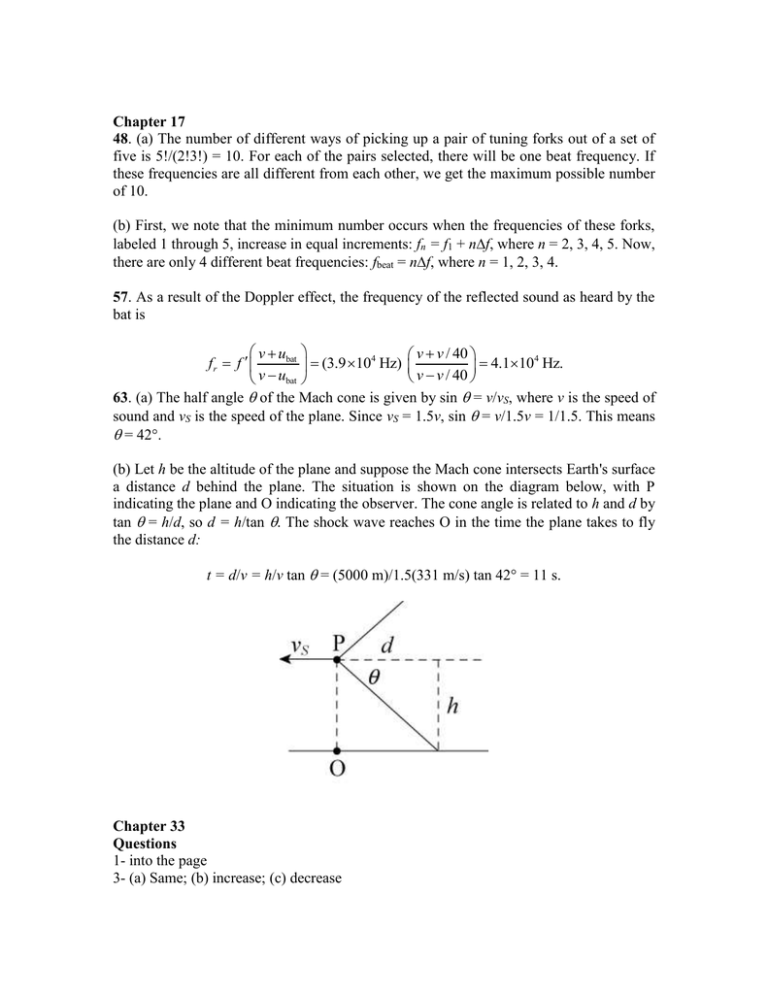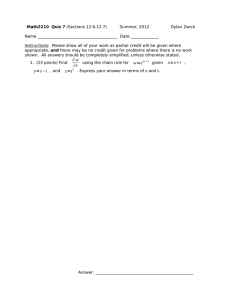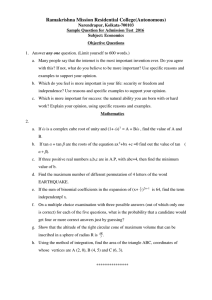Chapter 17 48
advertisement

Chapter 17 48. (a) The number of different ways of picking up a pair of tuning forks out of a set of five is 5!/(2!3!) = 10. For each of the pairs selected, there will be one beat frequency. If these frequencies are all different from each other, we get the maximum possible number of 10. (b) First, we note that the minimum number occurs when the frequencies of these forks, labeled 1 through 5, increase in equal increments: fn = f1 + nf, where n = 2, 3, 4, 5. Now, there are only 4 different beat frequencies: fbeat = nf, where n = 1, 2, 3, 4. 57. As a result of the Doppler effect, the frequency of the reflected sound as heard by the bat is v ubat v v / 40 4 4 fr f (3.9 10 Hz) 4.110 Hz. v u v v / 40 bat 63. (a) The half angle of the Mach cone is given by sin = v/vS, where v is the speed of sound and vS is the speed of the plane. Since vS = 1.5v, sin = v/1.5v = 1/1.5. This means = 42°. (b) Let h be the altitude of the plane and suppose the Mach cone intersects Earth's surface a distance d behind the plane. The situation is shown on the diagram below, with P indicating the plane and O indicating the observer. The cone angle is related to h and d by tan = h/d, so d = h/tan . The shock wave reaches O in the time the plane takes to fly the distance d: t = d/v = h/v tan = (5000 m)/1.5(331 m/s) tan 42° = 11 s. Chapter 33 Questions 1- into the page 3- (a) Same; (b) increase; (c) decrease 5- 20o and 90o Problems 3. (a) The frequency of the radiation is c 3.0 108 m / s f 4.7 103 Hz. 5 6 (10 . 10 )(6.4 10 m) (b) The period of the radiation is T 1 1 212 s 3 min 32 s. f 4.7 103 Hz 15. (a) The magnetic field amplitude of the wave is Bm Em 2.0 V / m 6.7 109 T. 8 c 2.998 10 m / s (b) The intensity is b g hc 2 2.0 V / m Em2 I 5.3 103 W / m2 . 7 8 2 0c 2 4 10 T m / A 2.998 10 m / s c h (c) The power of the source is P 4r 2 I avg 4 10m 5.3 103 W/m2 6.7 W. 2 26. The mass of the cylinder is m ( D / 4) H , where D is the diameter of the cylinder. Since it is in equilibrium Fnet mg Fr HD2 g D 2 2I 0. 4 4 c We solve for H: H 2I 2P 1 gc D 2 / 4 gc 2(4.60W) m) / 4](9.8m/s 2 )(3.0 108 m/s)(1.20 103 kg/m3 ) 4.91107 m. 2



